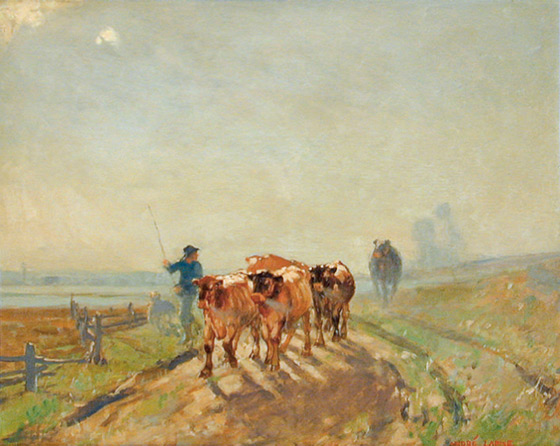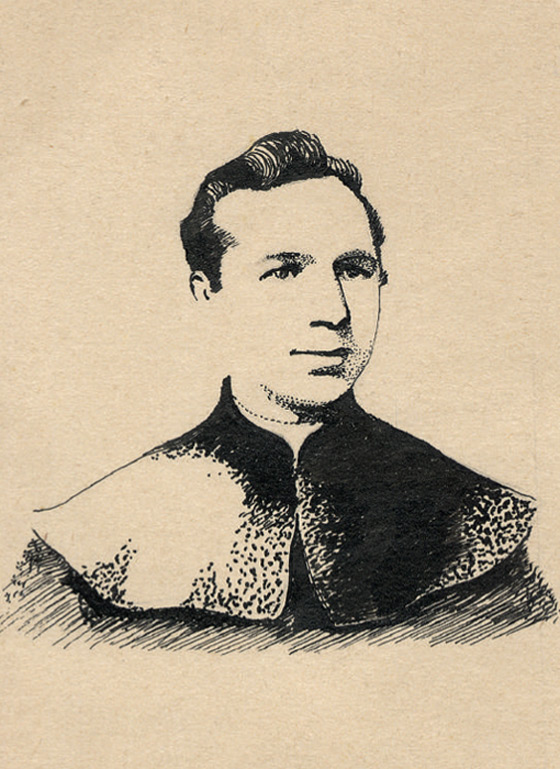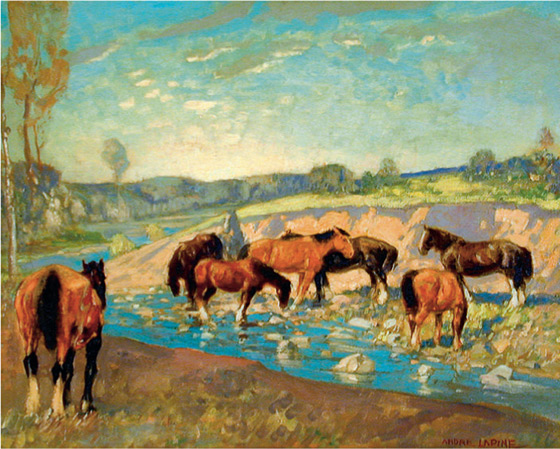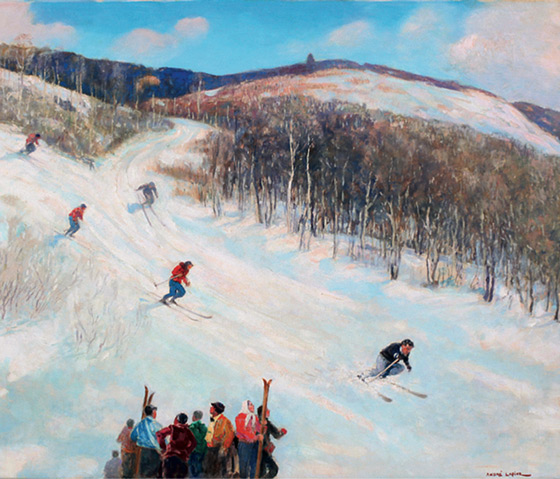|
|
| The gentle cavalier: the life and fate of Andre Lapine Marija Lakmane, Journalist, researcher | |
| It seems that he attracted women’s attention. maybe it was only desire without response, some hidden hope that never came true, or maybe it was just some kind of friendship (if we believe in strong friendship between a man and a woman) – but in any case it helped him many times in his life. people who knew Annette Brunelle said that she often remembered Andre lapine and in her 90s mockingly confessed “oh, no, no sex....” She passed away just a year before her 100th birthday and donated Andre’s letters and paintings to the Agnes jamieson gallery. these friendly letters that she received from him for many years usually begin with “my dear friend Annette...” and include polite greetings to multiple relatives. but they are full of romanticism and emotion and, like his paintings, describe the rural landscape beyond his window with lazy rain dripping from a barn’s roof, horses, haystacks and other attributes so different from busy downtown toronto life. unfortunately, english grammar with its neutral “you” is of little help in understanding the real development of Annette and Andre’s relationship. Agnes Jamieson, who met Andre as a doctor in a big toronto hospital, devoted herself a few years later to the small provincial town of minden, where he was bound to live till the end of his life. was it just a coincidence – who knows? She liked paintings and painted a little herself. After finishing her day busy with patients, she usually picked up Andre from his daily painting trips and drove him to his home. four years after his death, she left minden and returned there only after retirement, making everything possible to open a gallery displaying Andre’s and other artist’s paintings. this gallery is now named after her. Andre Lapine was not a particularly handsome man. he was of medium height with dark hair and moustaches or a small beard, usually wearing a bow tie and beret. if you ask somebody who knew him what he looked like, the answer will always include some of the following words: very polite, shy, tactful, intelligent. one journalist called him the gentle cavalier in a toronto newspaper in the mid-1930s, and there is still some charm and chivalry surrounding his name. | |
 Andre Lapine. Morning. Oil on canvas. 40.5 x 50.7 cm. Date unknown Publicity photo Courtesy of Mendel Art Gallery, Saskatoon, Canada | |
| Andreas Christian Gottfried (Andre) Lapine was born in 1866 in Skujene, some 130 kilometres from riga. there are references to the lapine family dating back to 1790 in the national Archives of Latvia. his grandfather (also Andre, sometimes written as lapping), after whom Andre was likely named, and his wife, darta, lived in Kalnemoise. they had two sons, paul and janis. the family later moved to Skujene, and in 1851 Janis married natalie julie krebs. both she and her father, karl gustav krebs, were school teachers in Skujene. According to some sources, janis was a tailor, but other sources state that he was a general contractor; it is impossible to verify which information is correct. janis and natalie had a daughter and three sons, one of whom – Andre, born on october 15, 1866 – later became a painter and whose life is described in this essay. The simple lutheran church in which Andre was baptised still stands today in Skujene. At the time of Andre’s childhood it had no pinnacle; that was built later. nearby there are the ruins of an old castle that i can imagine were explored multiple times by the boys of Skujene, including Andre. he liked to walk and explore nature all his life. maybe this pastime started during his early life in Skujene – it is there he listened to the sound of a river flowing and enjoyed country landscapes, horses, snow-covered spruces in winter – this love of the canadian countryside that he reflected in his paintings. There is no information about precisely when Andre became interested in painting/drawing. but the Academic library of the University of Latvia has a portrait of young fransis trasuns (a priest, statesman, writer and journalist who later became a notable figure during the national awakening in latgale) made by lapine in 1880 from which it’s clear that he had studied drawing. it is possible that Andre followed his older brother gottlieb, which appears in various essays about lapine written by the Canadian researcher Indra Gubiņa in the 1960s.1 it’s interesting that gottlieb is not mentioned in the national Archives of latvia as a member of the lapine family. but the same archives confirm that gottlieb lapine received his elementary education at the school in Skujene, and then he studied at the Cimze Seminary in Valka. between 1885 and 1895 he was a student at the baron Alexander von Stieglitz School of technical drawing. then he became a member of the “rūķis” (gnome) group of latvian artists. he worked as a teacher of drawing and calligraphy, and for the last ten years before retirement he taught german and drawing at the Alūksne gymnasium. After retirement he continued to be a painter for a number of years. | |
 Andre Lapine. Francis Trasuns at a young age. India ink drawing. 11.8 x 8.5 cm. 1880s Publicity photo Courtesy of the Academic Library collection of the University of Latvia | |
| There is no information about Andre’s early years in Skujene. i can imagine that he had many cousins, because his mother had many siblings. it is very likely he attended the only school in Skujene, where his mother taught. what we do know for sure is that at approximately the age of 16 he became a student of jānis Staņislavs roze, the founder of the latvian national school of portraits. he was taught by roze in a very academic manner, spending a lot of time drawing sketches of ancient sculptures. Andre did not enjoy this and felt a great relief when painting portraits of his family members instead. After a year and a half spent in riga, roze proposed that Andre continue his education in europe, and they both set off to germany in 1884, when Andre was 18 years old. From Germany they moved to London, where they stayed for two weeks visiting museums and meeting local painters. And then, finally, they arrived in paris, the cultural capital of europe. they visited museums and galleries, and Andre learned about impressionist paintings and possibly even met some of the painters. later, when writing about this period in his biography, lapine mentioned another young painter, josef weiss, whom he called “my old russian friend”.2 lapine left roze and started his own life, renting a studio together with josef. this “battle of life on his own wings” (as he described it himself)3 was not an easy one. they had some requests for copies from the louvre and the Art museum of the city of Luxemburg, but this was definitely not enough to keep them afloat. josef suffered from depression, left lapine and decided to start a new life in America; his traces are lost forever. Andre managed to get through this difficult time, though sometimes he paid his landlord by making portraits of his daughters.... There is information that during his stay in france lapine also visited Alsace-Lorraine and painted dozens of portraits. Some of them may probably be found in private collections, but nothing more specific is known about them. After france, luxemburg and belgium, lapine decided to move to holland. having little money, he walked there on foot, having occasional jobs and accommodations. his stay in Holland – over 20 years – was the longest of his european “tour”. Andre became a student of professor August Allebé (a well known painter who took care of many future artists) at the royal Academy of visual Arts (rijksakademie van beeldende kunsten). he received some money by working part-time as an illustrator. in April 1901 lapine became a member of the St. lucas Art Society. he was recommended by piet mondrian, a talented young 29-year-old artist who later became one of the founders of abstractionism. in one of the catalogues of this association i found lapine’s address in Amsterdam: raelof hartstraat, 64. this house is still there, only the upper storey was added later. | |
 Andre Lapine. Humber Valley. Oil on canvas. 40.5 x 50.7 cm. Date unknown Publicity photo Courtesy of Mendel Art Gallery, Saskatoon, Canada | |
| On August 5, 1897, Andre married collumbiena geertruida britt, a nurse from the small, old town of norg. geertruida (as everybody called her) was a slim, smiling woman with an inconspicuous face; she was one year older than Andre and from a big family of belgian settlers in holland. geertruida’s younger sister regula called her son Andreas christian gottfried, exactly the same name as on lapine’s birth certificate. who knows, maybe she was charmed by the gentle cavalier as well? unfortunately, Andre and geertruida never had children of their own. In 1905 the young couple decided to move to canada. without knowing it, they followed the same path as many other well known canadian artists before and after – they arrived in manitoba trying to find work on the farms there. fortunately, artists rarely become good farmers. After struggling for two years, the lapine family moved to toronto. in 1907 the city was one of the fastest growing cultural centres in canada. the Art gallery of ontario had opened there a few years before, and a few years later came the canadian Society of graphic Art, the royal Architectural institute, the canadian Art club and others. Andre was able to get a job at brigden’s ltd., which created illustrations for the well known Simpson’s and Eaton’s catalogues. he made connections with local painters and began participating in art exhibitions. from his start in toronto until 1934 he participated in many art exhibitions, including the prestigious canadian national exhibition. lapine’s La Noni was noted as the best portrait at the 40th exhibition of the canadian Academy of Art. this is how it was described in the international art magazine The Studio: “Against a yellow-grey background without any other objects or shadows is painted a figure of a young woman – demi-monde. noteworthy are the painter’s technical capabilities...; the best are noni’s eyes, they are so characteristic as to a rouse deep sympathy into the viewer.”4 In 1909 Andre became a member of the ontario Society of Arts. in 1915 the national Art gallery of canada commissioned his painting The Team, which was followed by The Windmill in 1918 and La Partida in 1923. in 1919 lapine was elected as an associate member of the royal canadian Academy of Arts. One of lapine’s favourite themes were horses. he was even called the best painter of horses in north America. these paintings are performed in different techniques and manners from more realistic to almost impressionistic. He worked a lot and created paintings and drawings using various techniques – oil, pen, charcoal, pastel, watercolour. his works were commissioned for many private collections. newspapers wrote about a “definite lapine’s cult” among art collectors in toronto and ontario. his position and income had become the most stable since the beginning of his career and, after so many years of living in casual rented apartments and studios, he allowed himself to have the home of his dreams in the prestigious toronto neighbourhood of etobicoke. ironically, after lapine this house has changed owners only twice and now it belongs to a retired dentist and art lover whose wife was also of latvian descent. | |
 Andrejs Lapiņš. Skiing. Sainte-Agathe. Oil on canvas. 63.5 x 76.2 cm. 1949 Publicity photo Courtesy of Agnes Etherrington Art Centre, Kingston. Canada | |
| Unfortunately, lapine and his wife were unable to enjoy this home for very long. on july 5, 1934, 67-year-old lapine was hit by a car while crossing the street just a few hundred meters from his home. the doctors at St. joseph hospital were sure that at his age and with so many injuries he would never walk again. there was not enough money for all the required surgeries and subsequent rehabilitation, because at that time geertruida had already been suffering from Alzheimer’s disease for some time and her care was a burden on the family’s finances, too. to help Andre, his friends arranged a fundraising art show and asked their fellow artists to donate their works. very many responded. to attract buyers, prices were kept low (a lawren harris painting was sold for just $40!) and there was a free performance by the toronto Symphonic orchestra. many toronto celebrities attended the show, including the lieutenant governor of ontario. After the show two art galleries continued selling the artworks. After a short time more than 100 pieces of art had been sold, which brought in enough money for lapine’s care and rehabilitation. do not forget that all this happened in the middle of the great depression in north America. despite the doctors’ initial predictions, some time later Andre bravely walked again, which newspapers called “the St. joseph miracle”. After his accident, lapine was forced to sell his house, and he and geertruida moved to hamilton’s farm near minden. in 1939 fate provided him with another surprise. “An elderly russian painter near buried himself near minden” says a newspaper heading.5 73-year-old lapine was helping a local farmer remove a huge (2 x 1.5 metres) rock from his field. when they had dug a big enough hole near the rock, lapine hesitated a bit at the bottom of the hole. the rock began rolling and it was another miracle that Andre survived. indra gubiņa wrote about the incident: “i would like to stress lapins’ very typical latvian characteristic, his love for work. it did not matter what the work was; if he decided that the work had to be done, he did it. he helped farmers and lumbermen not for gain, but for love of work.”6 two years later geertruida passed away at the farm.... Many sad events happened to lapine during these years, but he never gave up. in 1938 his painting The Departure was displayed at the century of canadian Art exhibition at tate gallery, london, england. the exhibition opening ceremony was attended by the royal family and drew a lot of attention from the public. Near the end of his life lapine continued to maintain relations restored his contacts with Annette brunelle, whom he had met many years ago while working at brigden’s. he visited her often at her house in a small town with the hardly pronounceable name of penetanguishene (locals call it penetang for simplicity), which was just an hour’s drive from his farm. the brunelle family were descended from the first french settlers that arrived in Quebec at the end of the 17th century and moved to penetang in the middle of the 19th century. Annette had ten siblings. At the age of 16 she decided to start her own life and she moved to toronto, where she changed jobs a number of times until finally settling down as a secretary at the Eaton’s company. i found Annette’s relatives and met them; only then did i understand why Andre visited her home in the 1940s, why he sent his greetings to all her family members, why he painted them (there are pencil drawings left). the only person knowing him is Annette’s sister pierrette, but she is very old now. however, i met with her daughter karen and her niece mary Anne. they keep very warm feelings about Andre and also his paintings, many of which Annette brunelle recently donated to the Agnes jamieson gallery in minden. talking to them i felt the warmth and friendship that surrounded lapine in their old red brick house on brock Street to which he addressed all his letters to Annette (unfortunately, this house now has different owners who have completely abandoned it). John desrochers, the famous local artist studied at penetang school. “once the teacher paula brunelle (mother of maryAnne myers) led us in the class the artist Andre lapin. it was a small man with graying hairs and a small beard. he showed us his sketches ... i remember that they were depicted horses, mach snow, it was beautiful! he was certainly a very talented man,” he recalls in november 1946, malloney’s Art gallery in toronto held lapine’s fourth solo exhibition. here are some quotes from the exhibition brochure: “canadians in all parts of the country have come to know and love Andre lapine and to recognise him as one of the few really great canadian artists. friendship brings real joy to him, and his kindly, lovable disposition and his great capacity for human understanding brings him many, many friends....” the exhibition contained his latest works – mostly calm landscapes of small ontario villages, muted colours, a slow pace – he “could really catch the spirit of a place”. lapine was already 80 years old, but he kept working, kept being a romantic and also literally kept going by walking many kilometres every day in search of the next motif for his paintings. Another major attraction in minden is welch’s house. the memorial plaque on its wall contains not a single word about Andre lapine. the house belonged to frank welch, who worked in the minden municipality and also owned funeral homes in the town. he was an art collector and a friend of Andre lapine; Andre often spent the night at frank’s house after his painting trips. After geertruida’s death they made an agreement: lapine would stay in welch’s house till the end of his life, and then he would leave all his paintings to welch. it’s not known whose idea it was, but lapine probably had no other choice. in any case, this goethe-like story has a silver lining to it, namely, welch donated all 45 of lapine’s paintings to the township of minden hills, and in 1981, due to the efforts of Agnes jamieson, an art gallery named after her was opened in minden. the gallery is now home to about 150 of lapine’s paintings, which is the largest known collection of his works. Andre Lapine passed away in 1952 at the age of 86. the grave he shares with geertruida can still be seen at the small minden cemetery. to the best of my knowledge, he is still unknown in his home town of Skujene. The author gratefully acknowledges the help of: laurie carmount, curator of Agnes jamieson gallery; jennifer nicoll, manager of collections at etherington Art centre; Sheila robertson, communications coordinator at mendel Art gallery; donald roch, registrar at mendel Art gallery; baiba pazane, chief archivist at the national Archives of latvia; elina riemere, librarian at cēsis central library; ilze miķelsone, curator at Alūksne museum; raven Amiro, copyright officer at the national gallery of canada; jessica Stewart, archivist at the national gallery of canada; karen and brine harris and Mary-Anne myers, relatives of Annette brunelle; john desrochers, painter; jan Snijders, archivist at Sint lucus Archives, holland, Andris Ķesteris, president of latvian national federation in canada. This material is published with some changes and additions after its first publication in the art magazine Золотая Палитра (russia). 1 one of them: Gubiņa I. Andrejs Lapiņš. Daugavas Vanagu mēnešraksts, #6, 1966. 2 from the letter of Andre Lapine to Eric Brown, director of the national gallery of Canada, july 15, 1916. 3 ibid. 3 Ibid. 4 the Studio, #76, 1919. 5 Watchman warder. lindsay, november 23, 1939. 6 Gubiņa I. Andrejs lapiņš. Daugavas Vanagu mēnešraksts, #6, 1966. | |
| go back | |







